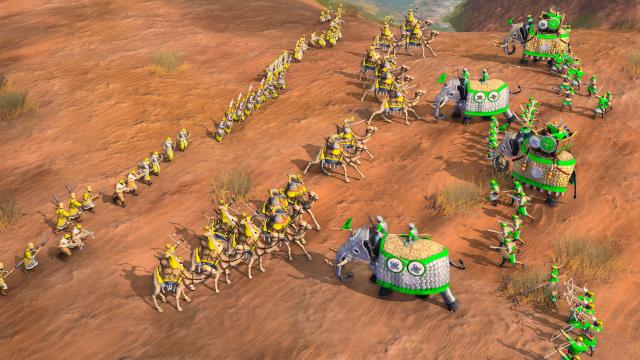A quick game’s a good game, they say. Apparently “they” never heard of Neptune’s Pride 2. But while there’ll always be a place for long, deep, thoughtful gameplay, it’s becoming more and more important to respect the player’s time.
As we found out last week, the average age for Australian gamers is now 35. Our passion for gaming is the same, but we all have less time and different life priorities. Meaningful experiences with small time investments become paramount. Games like Journey, which take only a few hours to play but stay with you and are great to talk about.
This is a design philosophy that RTS can, and needs to, learn from. Happily, the biggest RTS games are already on the right track. At some point close to the release of Legacy of the Void, Starcraft 2 realised its early game was partially redundant. It made the appropriate changes, and now you start with more gatherers and get into the action faster.
Age of Empires 4 gets this too. The pace of the game has increased in several ways.

It puts me in mind of games like Divekick or Fantasy Strike, which distill their genre down to its basic elements without losing high-level, strategic play. The mechanical inputs are basic, but the mind games aren’t. I’ve wondered: What would that distillation look like in other genres?
That’s a larger problem worth exploring further, but it seems particularly relevant in RTS since this is a genre in which you can spend many minutes before you’re even aware if the match was worth playing.
With unequal skill levels, the match ends before the endgame – but you won’t know it until after it’s played, having spent the majority of your time executing a build order.
Building a civilisation only to body your opponent in the first offensive is a lopsided gameplay experience. Seven minutes, maybe even 20 minutes of city-building, and only two minutes of crushing your enemies, seeing them driven before you and hearing the lamentation of their women.
To fix this, Age of Empires 4 gets everything cranking faster. You start with more villagers, and gathering rates are around double what they were in Age of Empires 2. You advance through the ages by building landmarks, rather than occupying your town centre during the age-up process.
To solve the problem of an absent endgame, it mostly shifted the endgame forward. Knights are available earlier. There are siege weapons in the Feudal Age, and trebuchets in the Castle Age. Religious units in some cases are available in the Dark Age. Map control, as a concept, properly begins in the Dark Age.
Whatever your game plan, you can start enacting it earlier.

That’s a world away from traditional Age of Empires build orders that would keep you going through rote motions until the 10-13 minute mark before the action starts.
From what I’ve seen from the beta and stress test feedback, AoE4 players wanted an even quicker game. Relic’s intuition was correct on this point, but even with all these moves in the right direction, it perhaps undershot the mark.
You can still spend quite a while in AoE4 before you even know if the match is worth playing, though if we’re talking longer than 10 minutes now, it’s because the stronger player is booming and the axe is simply yet to fall. But this is still an improvement – compared to past RTS games, AoE4 quantifiably respects the player’s time more.
Some of this comes down to matchmaking. As players are closer to each other in elo, they’re less likely to have an anticlimactic wet fart of an endgame. Higher-level players will also properly scout and prepare for what their enemy is cooking up. But we’re not really talking about the high elo players you see on Twitch and YouTube here.
I think this is a sentiment RTS developers will take note of. It won’t affect AoE4 too much, unless future updates slightly creep towards a speedier experience. All things considered, AoE4 is still a heck of a lot of fun, and the community will be enjoying it for years.
But as time goes on, conventional wisdom might become that the long arc of RTS is bending towards speed. Like Divekick before it, projects will embrace subtractive design, wondering what they can chop without losing meaningful content.
StarCraft 2 did it, Age of Empires 4 is doing it, and player sentiment seems to want to keep heading in the same direction. How long before we have a quick-fix, triple-A, 5-minute RTS?

Leave a Reply